Quick Summary:
Table of Contents
ToggleQuick Summary: Marble is a broad family of metamorphic stones formed from recrystallized limestone; **Carrara marble** is one specific Italian variety famous for its soft white/blue-grey background and subtle grey veining. The practical differences that matter for homeowners and specifiers are composition (all Carrara is marble, but not all marble is Carrara), visual characteristics (vein pattern, background tone), mechanical properties (porosity, hardness) and durability under wear, heat, moisture and acids. Choose Carrara for classic looks and accept higher maintenance; choose denser marbles or engineered surfaces (quartz) when durability and low maintenance are priorities. :contentReference[oaicite:0]{index=0}
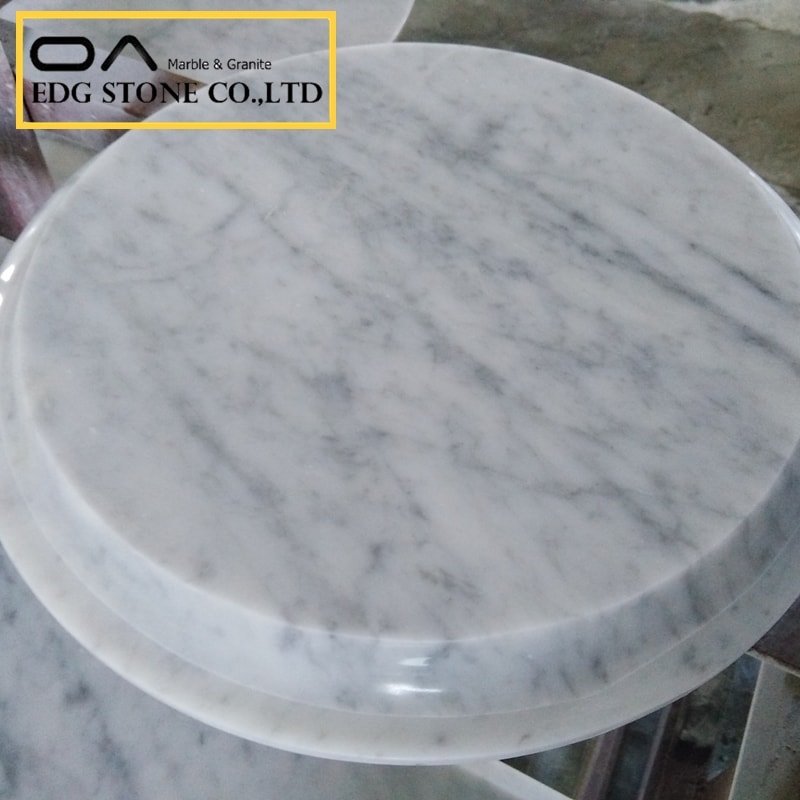
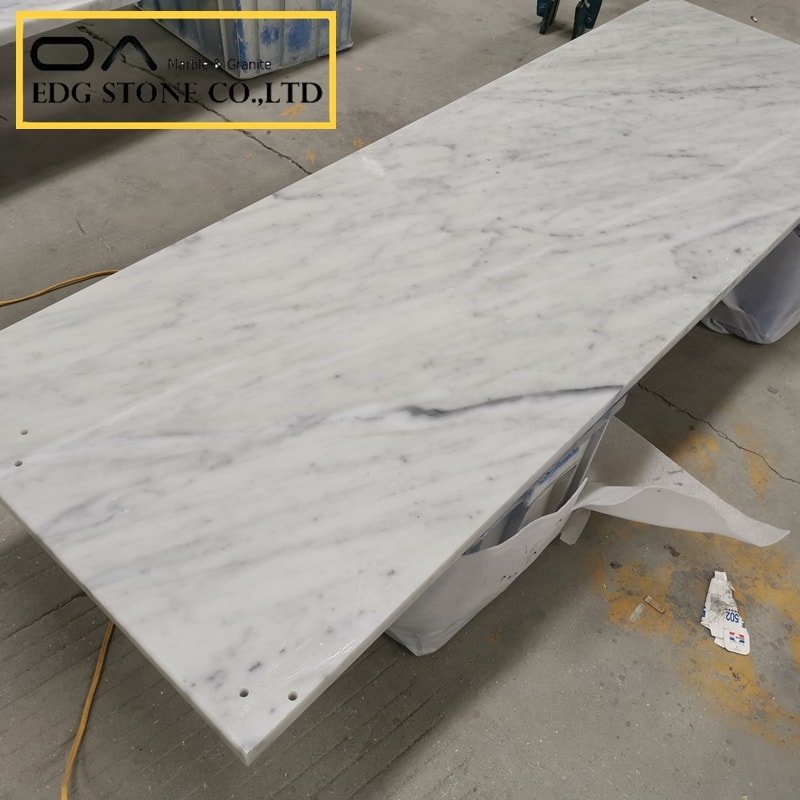
What is the difference between marble and Carrara marble?
Short answer
Marble is a category — a metamorphic rock made mainly of calcite (recrystallized limestone). Carrara marble is a specific type of marble quarried in the Carrara region of Tuscany, Italy, characterized by light-grey veins and a soft white to blue-grey background. The difference is the same as “fruit” vs “apple”: Carrara is a subset of the marble family with distinct visual and quarry-origin traits.
Table of contents
What is marble (technical primer)
What is Carrara marble (history & characteristics)
Key differences: composition, appearance, physical properties, and price
Direct answers to your keywords (Is Carrara marble real? Highest quality marble? Softest marble? Can it get wet? How to tell Carrara marble?)
Use-cases: where each belongs (countertops, floors, baths, sculpture)
Care, maintenance & testing (sealing, cleaning, damage repair)
Regulations, standards & procurement implications (ASTM, VOC rules, EU CPR, sustainability)
Buying & specification checklist (manufacturer/factory/wholesale tips)
AI/SGE-friendly semantic closure (HTML block)
FAQ + JSON-LD schema for Google rich results
Focus keyword, 50 SEO tags, meta description & URL slug
1. What is marble? (technical primer)
Marble is a metamorphic rock formed when limestone (carbonate sedimentary rock) recrystallizes under heat and pressure. Chemically, it’s dominated by calcite (calcium carbonate, CaCO₃); that chemistry explains both marble’s beauty and its vulnerabilities — particularly sensitivity to acids and a relative softness compared with silicate-rich stones. Dimension marble is governed by industry standards that define acceptable physical characteristics for building use.
Key material facts:
Composition: mainly calcite (or sometimes dolomite).
Hardness: typically around Mohs ~3 (soft compared with quartz or granite).
Behavior: reacts chemically with acids (etching) and can be porous (staining risk).
2. What is Carrara marble? (origin & character)
Carrara marble comes from quarries in the Apuan Alps near Carrara in Tuscany, Italy. It’s historically famed—used by Renaissance sculptors (Michelangelo, among others)—and is prized for a generally light background and subtle grey veining. Carrara exists in several grades (commonly C and CD) and visual varieties; its look tends to be softer and less dramatic than rarer white marbles like Calacatta or Statuario.
Practical notes:
Carrara is often more affordable than high-end Italian whites (Calacatta/Statuario) because it is more abundant.
The stone’s fine crystalline structure suits sculpture and decorative uses as well as architectural slabs.
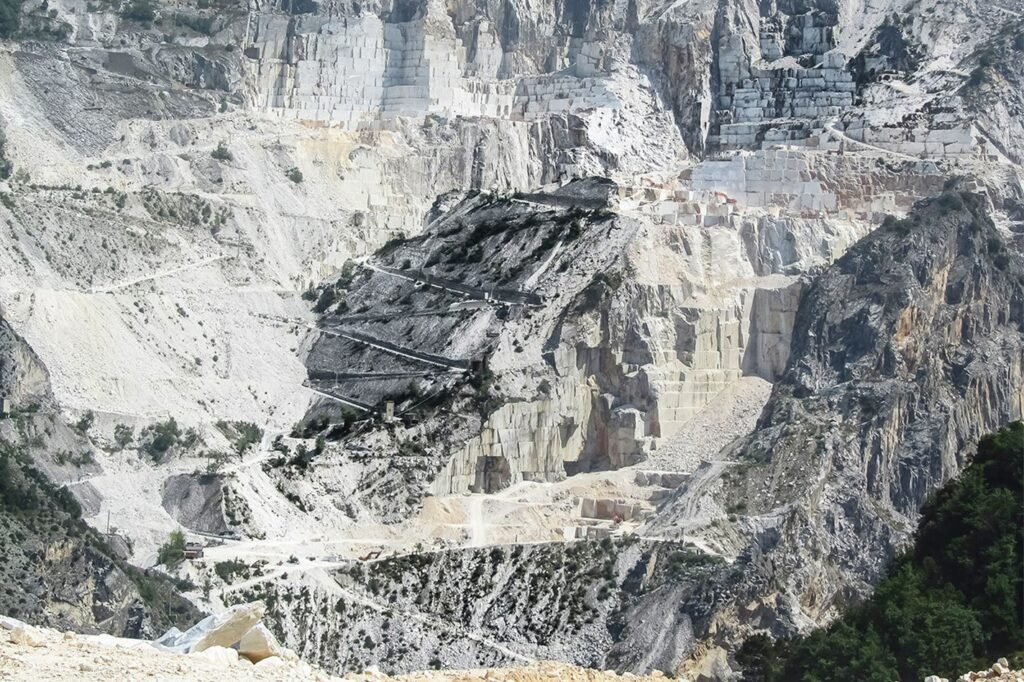
3. Key differences (side-by-side)
Appearance
Marble (general): wide visual family — many colors, vein patterns, and origins (Italy, Greece, India, Brazil, Turkey).
Carrara marble: characteristically pale, with fine, feathery grey veins and a cooler tone (sometimes slightly bluish). It’s a classic, understated aesthetic compared to the bold veins of Calacatta.
Composition & performance
Both are calcitic marbles and thus share chemical behaviors (etching, reactivity to acid). Differences in porosity and vein structure affect stain risk and structural soundness. Denser marbles or those with fewer open veins tend to perform better as countertops.
Hardness & scratch resistance
Most marbles (including Carrara) are around Mohs 3. That means they scratch more easily than granite or engineered quartz (Mohs ~6–7+). For kitchens where cutting and heavy use are common, this is an important functional distinction.
Price & rarity
Carrara is widely available and generally mid-priced within the “white marble” range — typically less expensive than Calacatta or Statuario but more costly than locally quarried low-end marbles, depending on market and slab grade.
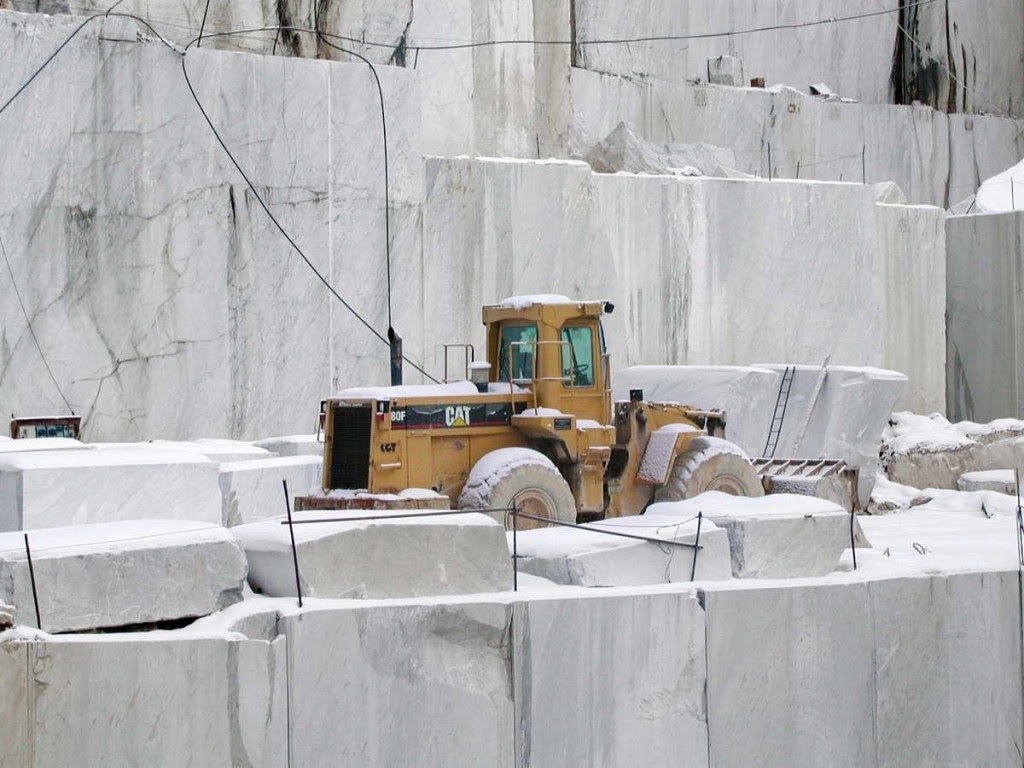
4. Direct keyword Q&A (SEO-focused answers)
Is Carrara marble real marble?
Yes. Carrara is authentic marble — a metamorphosed carbonate rock composed primarily of calcite. The term “Carrara” denotes origin and a recognizable visual family, not a different rock class.
What is the highest quality of marble?
“Highest quality” depends on the criteria:
Aesthetic rarity and market price: Calacatta and Statuario are usually considered the most exclusive and highest-value white marbles due to dramatic veining and bright white backgrounds.
Technical quality (soundness, low porosity, few fissures): a high-grade marble slab—regardless of type—will show fewer defects and better structural soundness per ASTM standards. Ask your supplier for ASTM C503 or equivalent test data.
What is the softest marble?
Softness varies slightly with mineralogy, but the most common marbles (including Carrara) are on the lower end of Mohs (~3). Softer decorative stones (e.g., certain limestones or soapstone) may test even lower. Use Mohs hardness as a practical guide for scratch susceptibility.
Can Carrara marble get wet?
Yes — Carrara can get wet. Marble is routinely used in bathrooms, wet rooms, and showers, but water exposure increases the risk of staining, efflorescence, or discoloration if installation or drainage is improper (e.g., trapped moisture in thin-set or grout). Proper sealing, correct installation, and choosing the right finish (honed vs. polished) are critical for wet-area performance.
How can you tell Carrara marble?
Look for:
Subtle, fine grey veins on a cool white/blue-grey background.
Origin certification or quarry info from the supplier (many reputable suppliers label origin).
Lab identification (petrographic testing) can confirm mineral composition (calcite crystals). Visual inspection plus supplier documentation is the usual method for buyers.
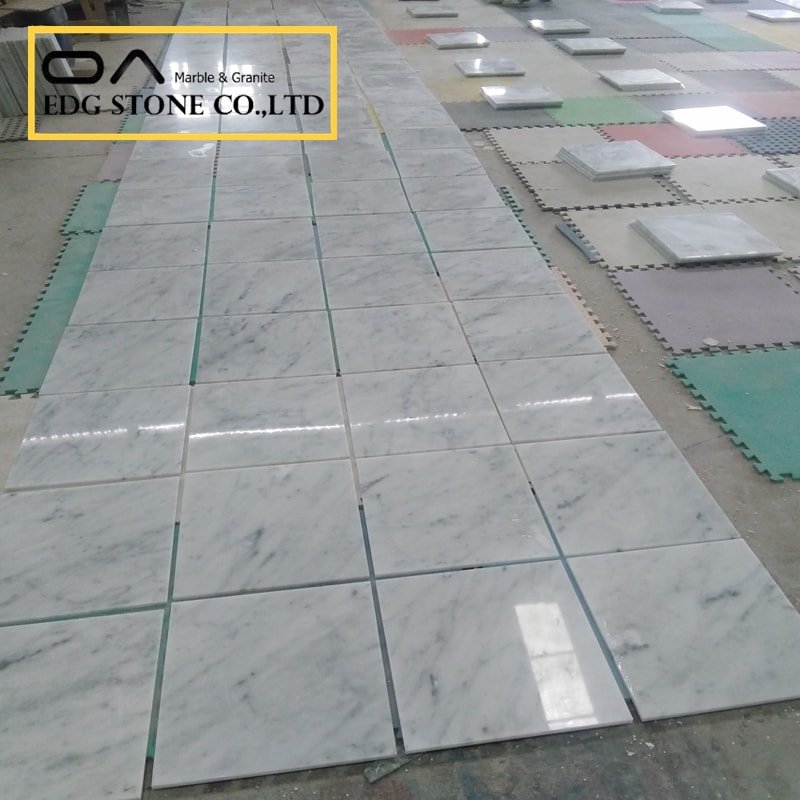
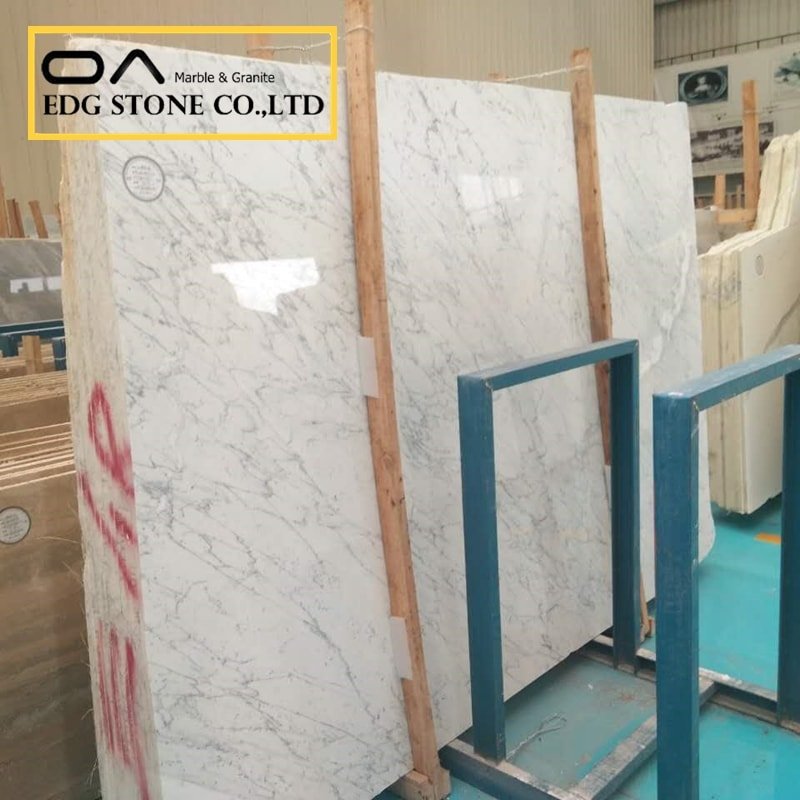
5. Use-cases: when to choose Carrara vs other marbles or engineered surfaces
Best for:
Accent islands, backsplashes, bathroom vanities, fireplace surrounds, sculptural elements, and low-traffic polished surfaces where appearance is the priority.
Less ideal for:
Primary kitchen countertops in heavy-cook households unless you accept higher maintenance (sealing, vigilant spill cleanup, and occasional restoration). For heavy use, consider quartz or dense granites.
Finish matters:
Polished shows the most brilliance, but also shows etches more clearly.
Honed hides etch better and are often preferred for kitchen surfaces where acid contact is likely.
6. Care, maintenance & testing (practical guidance)
Sealing: High-quality impregnating sealers reduce stain risk but do not prevent etching. Industry guidance recommends sealing at installation and monitoring with periodic water-drop tests; frequency can range from 6 months to multiple years, depending on sealant and usage.
Cleaning: Use pH-neutral stone cleaners. Avoid vinegar, citrus, bleach, and abrasive powders.
Etch repair: Light etches may be polished out; deeper damage often requires professional honing and re-polishing.
Testing before purchase: Ask for slab edge samples, perform a water blot test to check absorption, and request any ASTM/technical test results (soundness, porosity, flexural strength) relevant to your application.
7. Regulations, standards & industry trends (what specifiers should know)
ASTM C503 / C1527 / other dimension stone standards: professionals rely on ASTM standards for material acceptance, sampling, and physical property thresholds. Request relevant reports for structural or loaded applications.
VOC & installation products: adhesives, sealers, and some coatings used in stone installation can be regulated (e.g., California CARB rules, SCAQMD Rule 1168) — specify VOC-compliant adhesives and sealers when projects are in regulated jurisdictions.
EU Construction Products Regulation (CPR): procurement in the EU increasingly asks for performance declarations and environmental data; manufacturers are moving toward EPDs and improved traceability. This affects which slabs, sealers, and installation products are allowed or preferred on public projects.
Implication: Buyers (especially for commercial projects) should request ASTM test data, VOC certification for installation materials, and any EPD or traceability documents from the supplier to meet modern procurement standards.
8. Buying & specification checklist (manufacturer/factory / wholesale tips)
Ask for slab origin & grade (C/CD grading for Carrara or supplier grading).
Request ASTM test reports (C503 or similar) for structural uses.
Check for resin stabilization (some high-vein slabs are stabilized). Stabilization affects look and long-term behavior.
Confirm VOC compliance of adhesives/sealers if the project is in a regulated area. ww2.arb.ca.gov
Negotiate samples & lead time: for wholesale/factory buys, inspect full slabs where possible—veining can vary slab-to-slab.
9. Case snapshot (short)
A hospitality renovation specified Carrara for bathroom vanities and Calacatta for signature entry cladding. The design saved cost without sacrificing perceived luxury; maintenance plans specified sealed surfaces and a 12-month review for restoration. The project required supplier EPDs and VOC-compliant adhesives to meet public procurement standards. This mixed strategy is typical where designers balance look, function, and regulatory compliance.
Semantic Closure — How / Why / Options / Considerations
- How: Carrara is marble — the visual and mechanical differences come from local geology (vein density, impurities) and slab grade. :contentReference[oaicite:33]{index=33}
- Why: If you prioritize classic white marble aesthetics and accept maintenance, Carrara delivers iconic looks at a mid-range cost; if you need low maintenance, choose denser stones or engineered quartz. :contentReference[oaicite:34]{index=34}
- Options: Use Carrara for accent surfaces (islands, vanities, wall cladding) and pair with quartz/granite for high-use counters; prefer honed finishes to hide etches. :contentReference[oaicite:35]{index=35}
- Considerations: For commercial/public projects, require ASTM test data, VOC-compliant installation products, and supplier EPDs/traceability to comply with modern procurement and environmental rules (CPR, CARB). :contentReference[oaicite:36]{index=36}
- Action: Inspect slabs in person, request test data, and plan a maintenance budget (sealing + occasional professional restoration) before committing to Carrara in heavy-use areas.
FAQ — 5 Google hot-search items (human text, then JSON-LD below)
Is Carrara marble the same as marble?
Answer: Carrara is a specific type of marble from Carrara, Italy — so all Carrara is marble, but not all marble is Carrara. 維基百科What is the highest quality marble for countertops?
Answer: “Highest quality” can mean the most beautiful (Calacatta/Statuario) or the most structurally sound (high-grade slabs meeting ASTM specs). Decide if aesthetics or durability is your priority.Can Carrara marble be used in showers and wet areas?
Answer: Yes, but use proper installation, drainage, grout, and a sealing strategy; improper installation can trap moisture and cause discoloration.How do I tell authentic Carrara from look-alikes?
Answer: Authentic Carrara has distinctive fine grey veins and a cool white to blue-grey background; confirm with supplier origin documentation or lab petrographic testing if necessary.What cleaning products should I avoid on Carrara marble?
Answer: Avoid acid cleaners (vinegar, lemon), bleach, and abrasive cleaners. Use pH-neutral stone cleaners recommended by the Natural Stone Institute.
50 SEO tags (for CMS / tag cloud)
marble vs Carrara marble,Carrara marble characteristics,is Carrara marble real marble,how to tell Carrara marble,best marble for countertops,Calacatta vs Carrara,Statuario vs Carrara,marble hardness Mohs,marble porosity,can marble get wet,marble sealing guide,natural stone maintenance,marble cleaning products,avoid vinegar on marble,marble etching repair,Carrara slab wholesale,Carrara marble manufacturer,buy Carrara marble slab factory,marble supplier wholesale,ASTM marble standards,construction products regulation CPR,VOC compliant sealers,CARB adhesives sealers,EPD marble sustainability,marble procurement checklist,marble for bathrooms,marble countertops pros cons,honed vs polished marble,marble restoration cost,marble identification tips,authentic Carrara marble,Carrara quarry Tuscany,marble for sculpture,marble installation adhesives,marble grout and drainage,porous stone stain prevention,marble vs quartz differences,marble for kitchen islands,marble supplier certification,marble grading C CD,marble soundness testing,marble industry trends 2025,marble wholesale price per sqft,buying marble slabs online,stone fabricator tips,marble finish selection,marble patina over time,marble vs granite vs quartz,marble color variation,marble export importer,
